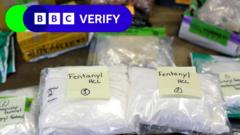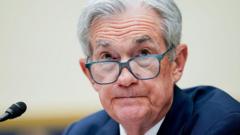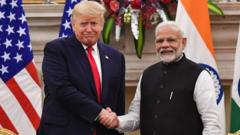This article explores the various channels through which fentanyl enters the United States, with a focus on the roles of China, Mexico, and Canada. It examines law enforcement strategies, political tensions related to tariffs, and the broader implications of the opioid crisis affecting American society.
Understanding the Fentanyl Crisis: A Multi-National Perspective

Understanding the Fentanyl Crisis: A Multi-National Perspective
The influx of fentanyl into the US is a complex issue rooted in international trade, law enforcement challenges, and socio-political dynamics.
In recent years, the United States has grappled with a fentanyl crisis that has devastatingly impacted public health. The powerful synthetic opioid has been linked to a staggering number of overdose deaths, peaking at over 74,000 fatalities in 2023 alone. Understanding how fentanyl permeates into the US involves analyzing the involved countries and the complex interplay of chemicals, drug trafficking networks, and government responses.
China is identified as the primary supplier of precursor chemicals crucial to the production of fentanyl. Despite tightening laws and placing certain chemicals under control, some manufacturers reportedly continue to provide these chemicals, often understanding their potential use in illicit drug production. This assertion is bolstered by numerous US indictments which highlight instances where Chinese firms supplied fentanyl production instructions via encrypted communication and cryptocurrency transactions.
On the ground, most of the fentanyl entering the US originates from Mexico. Authorities have indicated that Mexican drug cartels, such as the Sinaloa Cartel, have established sophisticated means of smuggling fentanyl into the US, utilizing deception tactics along with legitimate goods. US Customs and Border Protection (CBP) statistics reveal that an overwhelming majority of fentanyl seizures—98%—occur at the US-Mexico border.
The partnership between traffickers and suppliers manifests in a web of global trade in which criminal organizations operate with increasing audacity. While the Trump administration imposed tariffs on Chinese goods, accusing Beijing of failing to curb chemical exports, a concurrent focus on Mexico and Canada has taken shape regarding the facilitation of fentanyl smuggling. Mexico has rejected claims of collusion with cartels, categorizing such accusations as false.
Canada's role is also evolving, despite its minimal contribution to actual fentanyl seizures compared to Mexico. Organized crime groups in Canada are increasingly implicated in the drug's production by importing necessary materials from China. Recent data indicates a rise in fentanyl seizures during exchanges from Canada to the US, illustrating the transnational nature of the fentanyl trade.
To tackle the crisis, Canada has committed significant financial resources toward combating the spread of fentanyl, reflecting a broader recognition of the urgency of the issue. As the DEA updates its perspectives, the focus is beginning to shift toward India as a burgeoning source of fentanyl production materials, adding another layer to the complex supply chain.
As public health advocates and governments navigate the multi-faceted opioid crisis, tackling resource trade limitations, regional cooperation, and comprehensive drug enforcement policies remains paramount. The ongoing struggle against fentanyl abuse demands a united, global response to a crisis deeply embedded in international trade and local societal challenges.
China is identified as the primary supplier of precursor chemicals crucial to the production of fentanyl. Despite tightening laws and placing certain chemicals under control, some manufacturers reportedly continue to provide these chemicals, often understanding their potential use in illicit drug production. This assertion is bolstered by numerous US indictments which highlight instances where Chinese firms supplied fentanyl production instructions via encrypted communication and cryptocurrency transactions.
On the ground, most of the fentanyl entering the US originates from Mexico. Authorities have indicated that Mexican drug cartels, such as the Sinaloa Cartel, have established sophisticated means of smuggling fentanyl into the US, utilizing deception tactics along with legitimate goods. US Customs and Border Protection (CBP) statistics reveal that an overwhelming majority of fentanyl seizures—98%—occur at the US-Mexico border.
The partnership between traffickers and suppliers manifests in a web of global trade in which criminal organizations operate with increasing audacity. While the Trump administration imposed tariffs on Chinese goods, accusing Beijing of failing to curb chemical exports, a concurrent focus on Mexico and Canada has taken shape regarding the facilitation of fentanyl smuggling. Mexico has rejected claims of collusion with cartels, categorizing such accusations as false.
Canada's role is also evolving, despite its minimal contribution to actual fentanyl seizures compared to Mexico. Organized crime groups in Canada are increasingly implicated in the drug's production by importing necessary materials from China. Recent data indicates a rise in fentanyl seizures during exchanges from Canada to the US, illustrating the transnational nature of the fentanyl trade.
To tackle the crisis, Canada has committed significant financial resources toward combating the spread of fentanyl, reflecting a broader recognition of the urgency of the issue. As the DEA updates its perspectives, the focus is beginning to shift toward India as a burgeoning source of fentanyl production materials, adding another layer to the complex supply chain.
As public health advocates and governments navigate the multi-faceted opioid crisis, tackling resource trade limitations, regional cooperation, and comprehensive drug enforcement policies remains paramount. The ongoing struggle against fentanyl abuse demands a united, global response to a crisis deeply embedded in international trade and local societal challenges.






















